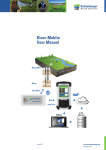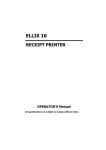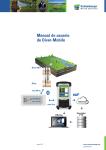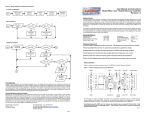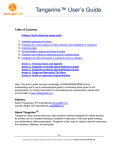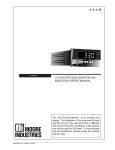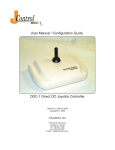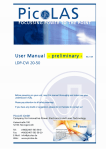Download Diver-Gate(M)
Transcript
Diver-NETZ User Manual Traditional data collection Diver-DXT Diver-DXT cable Diver FTP Server GPRS Radio Internet Status Bluetooth TM Charge Diver-Gate (M) Office June 2012 Office www.swstechnology.com copyright of SLB Version June 2012 All rights reserved. No part of this publication may be duplicated, stored in a computerized data file or made public in any form or manner whatsoever, be it electronic, mechanical, in photocopies, recordings or in any other way, without prior written permission from Schlumberger Water Services (Netherlands) BV Schlumberger Water Services Delftechpark 20 PO Box 553 2600 AN Delft The Netherlands Tel.: +31 (0)15 275 5000 www.swstechnology.com June 2012 www.swstechnology.com copyright of SLB WARNING TO USERS IN THE UNITED STATES Federal Communication Commission Interference Statement 47 CFR Section 15.105(b) This equipment has been tested and found to comply with the limits for a Class B digital device, pursuant to Part 15 of the FCC Rules. These limits are designed to provide reasonable protection against harmful interference in a residential installation. This equipment generates, uses and can radiate radio frequency energy and, if not installed and used in accordance with the instructions, may cause harmful interference to radio communications. However, there is no guarantee that interference will not occur in a particular installation. If this equipment does cause harmful interference to radio or television reception, which can be determined by turning the equipment off and on, the user is encouraged to try to correct the interference by one of the following measures: - Reorient or relocate the receiving antenna. - Increase the separation between the equipment and receiver. - Connect the equipment to an outlet on a circuit different from that to which the receiver is connected. - Consult the dealer or an experienced radio/TV technician for help. This device (Diver-DXT) complies with Part 15 of the FCC Rules. Operation is subject to the following two conditions: (1) This device may not cause harmful interference, and (2) this device must accept any interference received, including interference that may cause undesired operation. NO UNAUTHORIZED MODIFICATIONS 47 CFR Section 15.21 CAUTION: This equipment may not be modified, altered or changed in any way without signed written permission from Schlumberger Water Services (Netherlands) BV. Unauthorized modification may void the equipment authorization from the FCC and will void the Schlumberger Water Services (Netherlands) BV warranty. FCC and IC RF Radiation Exposure Statement: This device complies with FCC and Industry Canada RF radiation exposure limits set forth for the general population (uncontrolled exposure). This device must be installed to provide a separation distance of at least 20 cm from all persons and must not be collocated or operating in conjunction with any other antenna or transmitter. June 2012 www.swstechnology.com copyright of SLB IC REQUIREMENTS FOR CANADA This class B digital apparatus meets all requirements of the Canadian Interferencecausing equipment regulations. Cet appareil numérique de la classe B respecte toutes les exigences du règlement sur le matériel brouilleur du Canada. This device complies with Industry Canada licence-exempt RSS standard(s). Operation is subject to the following two conditions: (1) this device may not cause interference, and (2) this device must accept any interference, including interference that may cause undesired operation of the device. Le présent appareil est conforme aux CNR d’Industrie Canada applicables aux appareils radio exempts de licence. L’exploitation est autorisée aux deux conditions suivantes: (1) il ne doit pas produire de brouillage, et (2) l’utilisateur du dispositif doit être prêt a accepter tout brouillage radioélectrique reçu, même si ce brouillage est susceptible de compromettre le fonctionnement du dispositif. CE COMPLIANCE STATEMENT (EUROPE) This device is in conformity with the EMC directive and low-voltage directive. June 2012 www.swstechnology.com copyright of SLB Table of Contents Introduction1 Diver-NETZ components 2 Diver dataloggers 2 Diver-DXT cable 2 Diver-DXT2 Diver-Gate(M)3 Diver-NETZ software 3 Before you go into the field 4 Charging the Diver-Gate(M) battery 4 Bluetooth pairing of the Diver-Gate(M) with a mobile device 4 Setting up a USB connection between the Diver-Gate(M) and a PC 6 Installation of the Diver-DXT 10 Adjusting the cable length 10 Installation in a well with a synthetic flush mounted well cover 11 Installation in a well with a synthetic protective cover 11 Installation in a well with a metal protective cover 12 Maintenance13 Maintenance of Diver-DXT June 2012 13 www.swstechnology.com copyright of SLB Appendices Appendix I FAQ Diver-NETZ Appendix II Diver-DXT cable technical specifications Appendix III Diver-DXT technical specifications Appendix IV Diver-Gate(M) technical specifications June 2012 www.swstechnology.com copyright of SLB Introduction With Diver-NETZ technology, monitoring of ground and surface water becomes easier, faster and more reliable. Diver-NETZ is a wireless method for reading out Diver data and programming Divers. A physical connection between read-out equipment and the Diver is no longer necessary. With Diver-NETZ it is not necessary to find the monitoring well, the monitoring well finds you. A functional description of Diver-NETZ technology is presented in the diagram below. The monitoring well (with Diver-DXT installed) periodically tries to connect to a Diver-Gate(M) available within its radio range. This Diver-Gate(M) is connected to a mobile device (smartphone ,PDA or PC) using Bluetooth or a USB cable (only for PC). As soon as you have read out Diver data with a mobile device, you can transfer the data to a FTP server or keep it in the local queue. All data will be stored in the database of the device. Programs like Diver-Office and Diver-Office Premium are used to interpret, validate or visualize the Diver data. Any existing network of Divers can be quickly and easily fitted with the Diver-NETZ technology. FTP Server GPRS Radio Internet Status Bluetooth TM Charge Diver-Gate (M) Office Office Page | June 2012 1 www.swstechnology.com copyright of SLB Diver-NETZ components The components of the Diver-NETZ system are: • Diver datalogger(s) • Diver-DXT cable •Diver-DXT •Diver-Gate(M) • Diver-NETZ software applications (Diver-Mobile, Diver-Pocket or Diver-Office) Additional components of Diver-NETZ are: • plastic protective cap available in 2 models: •for 1 Diver-DXT •for up to 4 Diver-DXT • cable adaptors for fitting / shortening the cable Diver dataloggers Diver dataloggers are cost-effective and reliable instruments to provide long-term, frequent measurements of water levels, temperature and conductivity. Divers are ideal for monitoring municipal water supplies, salt water intrusion, brine storage and migration, and environmental monitoring of contamination and remediation projects. For more information on Diver dataloggers see the Diver Product Manual. Diver-DXT cable The Diver-DXT cable is used to connect a Diver to the Diver-DXT. The Diver-DXT cable is mounted into the Diver-DXT housing using a heavy-duty, water-tight connector that allows you to adjust the cable length as needed. This cable is available in different lengths (up to 300 meters). For more information see Appendix II. Diver-DXT The Diver-DXT makes wireless communication possible. The water-resistant housing contains a datalogger for recording barometric pressure and temperature. Furthermore, the Diver-DXT contains a battery and a radio module. The Diver-DXT is placed on top of a well, while the Diver is placed inside a well below groundwater level. Both units are connected using a two-wire Diver-DXT cable, which acts as a communication link and a mechanical link. The Diver-DXT is not meant to be used under water. The radio performance will decrease when the unit is covered or surrounded by water. However, sometimes it is difficult to avoid flooding conditions. Therefore the Diver-DXT has been developed to withstand this situation for a limited time (maximum of one meter water pressure for a duration of two days). For more information about Diver-DXT specifications, see Appendix III. Page | June 2012 2 www.swstechnology.com copyright of SLB Diver-Gate(M) The portable Diver-Gate(M) provides the communication between the Diver-DXT and the mobile device via a Bluetooth connection. The Diver-Gate(M) contains a radio module to communicate with the Diver-DXT. The unit also contains a Bluetooth radio for communication with a mobile device or PC. The Diver-Gate(M) works with an internal rechargeable lithium ion battery. There are four light-emitting diode (LED) indicators to indicate the charge status, the status of the radios (Bluetooth and the Diver-DXT radio) and the general operating status. • Radio LED: • Blinking: indicates scanning for Diver-DXTs • Continuously on: indicates data exchange between the Diver-Gate(M) and the Diver-DXT • Status LED: • Blinking: indicates operation mode • Continuously on: indicates (re)booting of the Diver-Gate(M) • Bluetooth LED: • Blinking (short on and long off): indicates making a connection or pairing with a mobile device • Fast blinking (almost continuously on): indicates Bluetooth connection mode • Charge LED: • On: indicates charging • Off: indicates no charging or the battery is charged To communicate with the Diver-DXT the Diver-Gate(M) is carried into the field to a position within radio range of the Diver-DXT. To protect the Diver-Gate(M) against environmental conditions a rubber protection guard is provided. Diver-Gate(M) technical specifications can be found in Appendix IV. Diver-NETZ software There are different software applications available, which can be used to communicate with the Diver-NETZ components: • Diver-Mobile: is a user-friendly mobile device application (Windows Mobile) to read out the data from dataloggers in the field. • Diver-Pocket: is a comprehensive mobile device application (Windows Mobile) to read out and configure dataloggers (when 2012 version is available). • Diver-Office: is a comprehensive PC application (Windows) to read out, configure and manage dataloggers. For more information about Diver-Mobile see the Diver-Mobile User Manual on the www.swstechnology.com website. Page | June 2012 3 www.swstechnology.com copyright of SLB Before you go into the field Before going into the field, the user needs to make sure the following steps are undertaken: • Charging the battery of the Diver-Gate(M) • Connecting the Diver-Gate(M) with a mobile device •Bluetooth pairing of the Diver-Gate(M) with a smartphone or PDA •Or setting up a USB connection between the Diver-Gate(M) and a PC Charging the Diver-Gate(M) battery When charging the Diver-Gate(M) for the first time it is necessary to use a USB charger (not provided) and not to charge using a laptop or PC. The Diver-Gate(M) needs to be turned ON while the charger is connected. Leave it ON until fully charged, indicated by the Charge LED turning off (approximately 5 hours). This procedure also needs to be performed if the device has not been used for more than two weeks. If the Diver-Gate(M) is used on a regular basis the device can be charged using any USB port (PC, car USB charge, etc.). In this case the Diver-Gate(M) can be turned off while charging. It is also possible to charge the Diver-Gate(M) continuously. Using the Bluetooth functionality of the Diver-Gate(M) while continuously charging is only possible with a USB charger and not with a USB port. Bluetooth pairing of the Diver-Gate(M) with a mobile device When the Diver-Gate(M) is used in combination with a mobile device and DiverMobile software, the radio link between the Diver-Gate(M) and the mobile device is based on a Bluetooth link. To enable the Bluetooth connection, the following steps illustrate how to pair a Diver-Gate(M) with a mobile device. • Attach the pairing dongle to the Diver-Gate(M). • Turn on the Diver-Gate(M). • Activate the Bluetooth function on a mobile device (usually found under the Settings menu) and set it to be discoverable or visible to other devices. • Open the Bluetooth connection settings and start searching for nearby Bluetooth devices. • Remove the pairing dongle. • After retrieving a list of nearby Bluetooth devices, select the Diver-Gate(M) (name is SWSGW_1414xxxxxxxx) (see example figure 1) and press Next. • Enter passcode “1234” and press OK (see example figure 2). • After the passcode is accepted, the name of the Diver-Gate(M) is displayed under disconnected devices (see example figure 3). • Select Diver-Gate(M) to modify its settings. • Activate “Serial port” (see example figure 4). • The Diver-Gate(M) will automatically restart (Status LED will be continuously on for 5 to 10 seconds). • After approximately 30 seconds the Bluetooth LED will turn on to indicate a Bluetooth connection. Page | June 2012 4 www.swstechnology.com copyright of SLB Figure 1: Search for Diver-Gate(M) Figure 2: Enter passcode Figure 3: Select and modify device Figure 4: Activate Serial Port Pairing between the Diver-Gate(M) and a PC is similar to the steps described above. Once the devices have been paired, the Diver-Gate(M) will automatically connect to the particular device when turned on the next time. The Diver-Gate(M) can only be paired with one other device. Page | June 2012 5 www.swstechnology.com copyright of SLB Setting up a USB connection between the Diver-Gate(M) and a PC When the Diver-Gate(M) is used in combination with a PC and Diver-Office 2012 software, the link between the Diver-Gate(M) and the PC is based on a USB connection. As an example, the following steps illustrate how to enable a USB connection between the Diver-Gate(M) and a Windows XP PC. When getting information that new hardware has been found, open the Found New Hardware Wizard and: 1.Choose the option to connect to Windows Update to search for software and click Next. 2.Select the option to install software from a list or specific location and click Next. Page | June 2012 6 www.swstechnology.com copyright of SLB 3.Choose the option to select the device from a list and click Next. 4.Click Have Disk option. 5.Click Browse option. Page | June 2012 7 www.swstechnology.com copyright of SLB 6.Browse for gserial.inf. This file can be downloaded from the www.swstechnology.com website. Click Open. 7.Click OK. 8.Select Next to continue. Page | June 2012 8 www.swstechnology.com copyright of SLB 9.Click the Continue Anyway button. 10.Click Finish. The software is successfully installed. For additional information about setting up a USB connection between the DiverGate(M) and a PC, please have a look at the ‘Diver-Office Installation Guide-DiverGate(M) driver installation’ on the www.swstechnology.com website. Page | June 2012 9 www.swstechnology.com copyright of SLB Installation of the Diver-DXT The Diver-DXT is a radio module with a built-in datalogger for barometric pressure. Together with a built-in battery the Diver-DXT will operate independently from the connected equipment. However, the system will only be functional if a Diver-DXT cable and Diver are connected. The complete equipment for the well is: • Diver datalogger (see supported Diver datalogger list). • Diver-DXT cable to connect the Diver to the Diver-DXT. • The Diver-DXT (which is placed on top of the well or outside the well protection). Adjusting the cable length It is important to determine the proper cable length for the Diver for the following reasons: • If the cable length is too short: •the Diver will be located above the water level. This will not damage the Diver, but the Diver will no longer record water levels. • If the cable length is too long: •the Diver can be subjected to excessive pressure from the water column on top of the Diver. This can harm the Diver and the Diver will no longer record water levels. •the Diver can end up at the bottom of the well and this can affect the reliability of the Diver data. It is important to know the highest and the lowest expected water levels from the top of casing (TOC). The difference between the highest and lowest water levels is important to define the pressure range of the Diver and the length of Diver-DXT cable. There are two methods to adjust the cable length: • Integrated Diver-DXT cable length adjustment. This method is used if the Diver-DXT is placed on the TOC. • With a cable adaptor. This method is used if the Diver-DXT is placed on top of the well protection cover. In this situation the cable adaptor is placed on top of the casing Effective working length of the cable The next paragraphs illustrate how to install the Diver-DXT in the following situations: • installation in a well with a synthetic flush mounted well cover • installation in a well with a synthetic protective cover • installation in a well with a metal protective cover Page | June 2012 10 www.swstechnology.com copyright of SLB Installation in a well with a synthetic flush mounted well cover Flush mounted well covers are often used in an urban environment. Most of these flush mounted well covers are made of synthetic materials which allow the use of radios (such as the Diver-DXT). Metal flush mounted well covers, however, are not suitable for use in combination with the Diver-DXT. The Diver-DXT is placed on top of the casing. The space from the top of the casing to the bottom of the synthetic protection cover needs to be at least 30 mm. If the location has more than one casing it is possible to use more Diver-DXTs. In this case there will be no interference between the Diver-DXTs. For radio performance it is important to have the Diver-DXT placed as closely as possible to the cover of the flush mounted well. The radio performance will decrease if the distance between the Diver-DXT and the ground surface increases. Instrumentation is not visible when the cover is closed and it is therefore protected against vandalism. When the Diver-DXT is ready to be installed in a well the next action points are needed: • Take a manual water level measurement from the TOC before the Diver-DXT with the Diver is lowered into the well. • Measure the distance between the membrane of the Diver and the bottom of the Diver-DXT radio unit (= cable length). Effective working length of the cable (Baro-, Cera-, Mini- en Micro-Diver) • Place the Diver-DXT with the cable and Diver connected to it in the well. Installation in well with synthetic protective cover Most wells consist of a protective cover above ground level. Some of these protective covers are made of metal while others are made of a synthetic material. The installation of the Diver-DXT in a synthetic protection cover is similar to the installation in a flush mounted well cover. The Diver-DXT is placed on top of the casing. The space from the top of the casing to the bottom of the synthetic protective cover needs to be at least 30 mm. If the location has more than one casing it is possible to use more Diver-DXTs. In this case there will be no interference between the Diver-DXTs. The protective cover and lockable cap/cover will secure the installation against vandalism. Instrumentation is not visible when the cap is closed. When the Diver-DXT is ready to be installed in a well the next action points are needed: • Take a manual water level measurement from the TOC before the Diver-DXT with the Diver is lowered into the well. • Measure the distance between the membrane of the Diver and the bottom of the Diver-DXT radio unit (= cable length). Page | June 2012 11 www.swstechnology.com copyright of SLB Effective working length of the cable (Baro-, Cera-, Mini- en Micro-Diver) • Place the Diver-DXT with the cable and Diver connected to it in the well. Installation in a well with a metal protective cover Most wells consist of a protective cover above ground level. Some of these protective covers are made of metal while others are made of a synthetic material. Because the Diver-DXT cannot be used inside a metal enclosure an alternative installation is needed. The Diver-DXT cannot be placed inside the metal enclosure because of the shielding of radio signals. Therefore the Diver-DXT has to be placed outside the metal protective cover. This can be done by drilling holes in the cap and placing the DiverDXT on top of the cover. It is also possible to place more than one Diver-DXT on top of the protective cover. A drilling stencil is available for drilling the required holes. An extra sturdy protective cover is available to protect the Diver-DXT against vandalism. When the Diver-DXT is ready to be installed in a well the next action points are needed: • Take a manual water level measurement from the TOC before the Diver-DXT with the Diver is lowered into the well. • Measure the distance between the membrane of the Diver and the cable adaptor (= cable length). Effective working length of the cable • Place the Diver-DXT with the cable and Diver connected to it in the well. Page | June 2012 12 www.swstechnology.com copyright of SLB Maintenance Maintenance of Diver-DXT The Diver-DXT has a built-in datalogger for the barometric pressure and ambient temperature. The sensor is located under the upper part of the Diver-DXT (see figure below). This sensor should be in open contact with the air pressure. Maintenance is needed to keep the area around the location of the sensor clean. Extreme high and low temperatures, mud, moisture or water could affect the accuracy of the sensor. Clogging of the sensor opening can result in sensor drift/deviation. Page | June 2012 13 www.swstechnology.com copyright of SLB Appendices June 2012 www.swstechnology.com copyright of SLB Appendix I June 2012 www.swstechnology.com copyright of SLB FAQ Diver-NETZ How do I store and handle the equipment? Before installation, the equipment should be stored in a safe place. However, it is important to know what the effects of storage are for the instrument. The Diver-DXT has a built-in battery which cannot be switched off. This means that the instrument is always active and consumes energy from the battery. The total battery capacity will be reduced by approximately 4% per year in storage conditions. Another important storage condition is the ambient temperature. If the instrument is stored for a long period of time (more than one month) it is best to store the instrument in a dark place at room temperature. HANDLE WITH CARE The instrument is tested for transport conditions according to ASTM D 4169-09 DC 2 (transport simulation test). This globally accepted standard ensures no damage if the instrument is transported under normal conditions in its own packaging. Keep the instrument in the original packaging until it is installed in the field. The instrument is also tested according to MIL-STD-810 and ASTM D 3332 (shock and vibration tests). This test simulates the mechanical shocks and vibrations during installation of the Diver-DXT. Although the equipment can handle these conditions, it is better to avoid any abnormal shocks and vibrations if possible. The Diver-DXT has sensors which need to be handled with care. How does Diver-NETZ work? The figure below depicts the setup of the Diver-NETZ. From left to right: The Diver is suspended on a Diver-DXT cable with on top the Diver-DXT. The Diver-DXT sends information (data) wirelessly to the Diver-Gate(M). The Diver-Gate(M) can be wirelessly connected through Bluetooth to a Windows Mobile based device. On this device the Diver-Mobile application needs to be installed to communicate with the Diver. The Diver-Mobile application will store the Diver data and can optionally send the data to a FTP server. FTP Server GPRS Radio Internet Status Bluetooth TM Charge Diver-Gate (M) Office June 2012 Office www.swstechnology.com copyright of SLB What is the radio range between the Diver-Gate(M) and the Diver-DXT? The radio technology of the Diver-DXT and the Diver-Gate(M) makes use of the ISM (Industrial, Scientific and Medical) band. Specifically, the 2.4 GHz radio frequency is used. This radio band is unlicensed, which means that the frequencies are open for public use and require no registration or payment for usage of the frequency. In order to comply with the regulations, the output power of the devices is regulated. This regulation may cause limited range of the radio device. Typically, the radio range of the Diver-DXT device is about 500 meters (1,300 ft) line-of-sight (LOS). Certain characteristics inherent to the environment where the system is deployed may affect the range of the radio system. This includes, but is not limited to, rain, snow, fog, large bodies of water, trees, forests, metal well protective covers, buildings, atmospheric conditions, ambient frequencies, noise, electromagnetic fields and general conditions of the terrain. Besides, the positioning of the Diver-DXT may affect the range of the radio system as well. To maximize the performance of the radio devices, it is recommended to place the Diver-DXT in an area where it is possible to “see” the device without obstacles in between. This is not mandatory, but improves the performance of the system. If this condition is not met, the performance of the system may be reduced. We therefore recommend a site assessment in order to plan and optimize the deployment of devices. What do I need to know about Bluetooth? Bluetooth is a simple two-way wireless radio technology that allows different devices to connect between each other without the use of cables or infrared waves. This technology is robust, low-power and low-cost. The short range radio link provides connectivity between different devices, such as mobile phones, PDAs, PCs and other electronic devices. It is designed to be used in small range communication and allows voice and data communication. It operates in the 2.4 GHz radio spectrum. Each class provides a different power output and they have different communication ranges. This is certified in three different types of standard: Class 1 (100 meters), Class 2 (10 meter), Class 3 (1 meter). The Diver-Gate(M) has a Class 2 (10 meter) Bluetooth module. Can I use a mobile phone? Yes, mobile phones with the following specifications can be used for Diver-NETZ: • Windows Mobile version 6.1 and higher • Minimum of 4 GB of Flash memory (SD card) • Minimum of 128 MB of RAM • Bluetooth version 2.0 and later • Data-plan: if you want to send the data to a FTP server June 2012 www.swstechnology.com copyright of SLB Can I use a Pocket-PC? Yes, Pocket-PCs with the following specifications can be used for Diver-NETZ: • Windows Mobile version 6.1 and higher • Minimum of 4 GB of Flash memory (SD card) • Minimum of 128 MB of RAM • Bluetooth version 2.0 and later • GSM/GPRS option and a dataplan if you want to send the data to a FTP server Can I use a laptop? Yes, you can use a laptop with Diver-Office 2012.1. The following hard- and software requirements are needed to install Diver-Office 2012.1: • Operating system: Windows XP (SP2 or later, 32 & 64-bit), Windows Vista Business (32 & 64-bit) or Windows 7 Professional (32 & 64-bit) • Processor: Pentium 4-compatible processor or higher, 1.6 GHz or higher recommended • Hard Disk: 2GB (3GB or more recommended) • Memory: 1GB RAM (2GB or more recommended) • Serial communication: One available USB port or one Serial COM port • Screen resolution: 1024 x 768, color: 16 bits • Microsoft SQL Server Compact Edition 3.5 SP2 (included in installation package) In what languages is Diver-Mobile available? The Diver-Mobile application is available in the English language. Can I use my own FTP server? Yes. In the Diver-Mobile application you can set the address of the FTP server. What are the requirements for a FTP server? The FTP server must be a standard none secured FTP server. Can I use my existing Diver Data Cables? Yes, you can use your existing DDC cables. However, the connector of the DDC cable needs to be modified by SWS. What is the maximum cable length that can be used? The maximum cable length is 300 meters. How long does the battery in the Diver-DXT last? The nominal battery lifespan is 5 years. The battery can be replaced SWS. What are the max/min operating temperatures of the Diver-DXT? The Diver-DXT operating temperature range is from -20 °C up to +80 °C. The battery life time will decrease when the device is used below 0°C and/or above 40°C. How much water can be on top of the Diver-DXT? The Diver-DXT is designed to withstand 1 meter water pressure for 2 days. Please note that the barometric sensor will not measure the barometric pressure while immersed in water. June 2012 www.swstechnology.com copyright of SLB Is the old Diver-DXT compatible with the new Diver-DXT? No, the new Diver-DXT is not compatible with the old Diver-DXT (produced until 2009). Can I download the barometric data when the Diver-DXT fails? No. The Diver-DXT must be returned to SWS. In most cases SWS can retrieve your data from the Diver-DXT. How long does the battery in the Diver-Gate(M) last and how can it be recharged? The battery in the Diver-Gate(M) can be used for 10 hours without the need for recharging. The Diver-Gate(M) is recharged through the USB port on the DiverGate(M). I fully charged the battery but when I turn on the Diver-Gate(M) all the LEDs go off after a few seconds? When a Diver-Gate(M) with fully charged battery turns off or if you unplug and plug the internal battery, it is necessary to follow the following procedure: • Connect the USB cable to the Diver-Gate(M) • Switch on the Diver-Gate(M) • The status LED should start blinking for at least 30 seconds • After several minutes the battery level is calibrated with the battery. You can leave the device on during charging Can I start/stop/reprogram a Diver with Diver-NETZ? Yes, this can be done with Diver-Office 2012.1 and Diver-Pocket (when version 2012 is available). Can other people connect with Diver-NETZ to my Divers? The Diver-DXT and the Diver-Gate(M) can be protected by a Network-ID. What to do when you get an error while starting Diver-Mobile? If the Diver-Mobile application generates the following error “No Diver-Gate(M) found”, there is no Bluetooth connection between the Diver-Gate(M) and a mobile device. See FAQ “I do not have a Bluetooth connection between the Diver-Gate(M) and the mobile device”. I do not have a Bluetooth connection Between the Diver-Gate(M) and the Mobile Device? Please follow the next steps: • Check the Bluetooth LED of the Diver-Gate(M). This LED should blinking fast (almost continuously on) • If the Bluetooth LED doesn’t blink at all (not even for a short period) the Diver-Gate(M) has to be paired. Follow the Bluetooth pairing procedure • If the Bluetooth LED does blink but will not go into an almost continuous mode (indicating the Bluetooth connection), the Bluetooth of the mobile device is not visible to the Diver-Gate(M). Change the Bluetooth settings of the mobile device to “Always Visible” • If the Bluetooth LED indicates a Bluetooth connection but the application cannot find the Diver-Gate(M) it is possible that the serial port check box in the Bluetooth settings is not ticked. Tick this box (enable serial port) and try again. June 2012 www.swstechnology.com copyright of SLB I don’t have Bluetooth connection between the Diver-Gate(M) and a mobile device anymore but it worked in the past? Check if Bluetooth is enabled. Check the Bluetooth status on your device (PC, mobile device). Some devices also have a switch that shuts down all radios (WiFi and Bluetooth). Make sure this switch is on. I do not have a radio connection between the Diver-Gate(M) and the Diver-DXTs? Please follow the next steps: • If you have no connection after 30 seconds you may be out of radio range. Try to move closer to the Diver-DXT and re-establish the connection. Try this a few times from different locations. • From 07:00 PM to 07:00 AM the radio of the Diver-DXT will be in sleep mode to save battery capacity. Making a connection can therefore take more time (longer than 5 minutes). • Make sure you use the correct Network ID. For selecting the correct Network ID see the Diver-Mobile Manual. • Check if the Radio LED on the Diver-Gate(M) is blinking during scanning and continuously on during data transfer. If not, the problem could be the Diver-Gate(M). Diver-Mobile is unresponsive. What should I do? Go to Task Manager and shut down the Diver-Mobile application or give your field device a soft reset. How to do this is described in the user manual of the field device. June 2012 www.swstechnology.com copyright of SLB Appendix II June 2012 www.swstechnology.com copyright of SLB Technical Specifications Diver-DXT cable Article number Ingress protection Length accuracy Cable stretch Maximum length Cable length adjustment Temperature range Material of connectors Material of cable jacket AS2xxx.x* IP68** ±1% (≥1 cm) <1% 300 m up to 40% of maximum length -20°C to 80°C nylon PA6, fibreglass-reinforced (30%) polyurethane (PU) Cable length according to customer specifications. * AS2xxx.x (xxx.x is length in meters). Example: AS2015 is 15 m and AS2001.5 is 1.5 m. ** Only if connected to Diver-DXT. June 2012 105 mm D = 23.3 mm 110 mm D = 22 mm Specific length of the cable D = 3.2 mm 97 mm Effective working length of the cable (Baro-, Cera-, Mini- en Micro-Diver) D = 49 mm D = 18 mm 44 mm 89 mm Specific length of the cable Effective working length of the cable (CTD-Diver) 28.5 mm Diver-DXT dimensions www.swstechnology.com copyright of SLB Appendix III June 2012 www.swstechnology.com copyright of SLB Technical Specifications Diver-DXT General Diameter Ø 49-23 mm Length 141 mm (including chassis connector) Weight 84 g Housing material High Heat ABS Polylac® casing, Viton® and MBR o-rings, Cu Zn/Ni connector ProtectionIP68 Operating temperature (OT) -20°C to 60°C (within specs) Maximum operating temperature (MOT) -20°C to 80°C (not guaranteed within specs) Storage / transport temperature * -40°C to 85°C Battery life 5 years @ OT, depending on operation and maximum 3,000 connections with Diver-Gate, 30,000 memory block reads (dataset if 84 bytes) Battery Non-rechargeable lithium-thionyl chloride (3600 mAh) Battery replacement By manufacturer Instrument interface Diver-DXT cable with Baro-Diver, Mini- Diver, Micro-Diver, Cera-Diver and CTD-Diver Datalogger barometer Storage capacity Measuring interval Measuring method Clock accuracy Recorded parameters 24,000 measurements (non-volatile memory) 60 min Fixed time based Automatic synchronization with attached Diver (once a day) Barometric pressure (cmH2O) and temperature (°C) Barosensor Sensor Range Accuracy Resolution Absolute maximum pressure (MP) Absolute maximum burst pressure Long-term stability Piezo-resistive silicon micro machined sensor 400-1,150 cmH2O ±1 cmH2O (typical) ±2 cmH2O (maximum) @OT 0.1 cmH2O 1.5 bar (absolute) 2 bar (absolute) @1 sec ±1 cmH2O/year (typical) @OT Temperature Sensor Range Accuracy Resolution Silicon temperature sensor -20°C to 80°C ±1°C (typical) ±3°C (maximum) @OT 0.1°C June 2012 www.swstechnology.com copyright of SLB Radio Radio frequency (central frequency) Transmit power Scan-for-host period Radio range Data encryption 2.405 GHz (channel 11) 100 mW, 20 dBm 14 seconds (7:00AM-7:00PM), 300 seconds (7:00PM-7:00AM) 500 m LOS (Line-of-sight) AES key (16 bytes) Environment Operating temperature Operating elevation range Pressure Random vibration Mechanical shock Transportation Certification -20°C to 60°C (within specs) -300 to 5,000 m MSL (mean sea level) Up to MP (in air) MIL-STD-810: 10 Hz 0.02 g2/Hz, 60-1,000 Hz 0.02 g2/Hz, 1,000-2,000 Hz 6 dB/oct ASTM D 3332: Free-fall drop 0.1 to 0.7 m (500 g @ 2 ms) According to ASTM D 4169-08, DC2 (out side of western Europe by lorry/air/boat) CE: R&TTE Directive 1999/5/EC according to the harmonized standards FCC ID: V43DIVERDXT2 IC: 7675A-DIVERDXT2 *The Diver-DXT is always active. The leakage current of internal battery mostly depends on the temperature. If stored or transported for a longer period of time at elevated temperatures, the battery life time will be affected. June 2012 www.swstechnology.com copyright of SLB Appendix IV June 2012 www.swstechnology.com copyright of SLB Technical Specifications Diver-Gate(M) General Dimensions Weight Housing material Protection Operating temperature Storage / transport temperature Power supply Battery life Communication 138 x 62 x 34 mm (with protection guard) 181 g ABS casing IP52 (with protection guard) -20°C to 60°C (within specs) -40°C to 85°C Internal rechargeable lithium ion battery, charged through USB port 10 hours (typ) in Bluetooth connection mode USB port, Bluetooth® Bluetooth Module Antenna Fully qualified Bluetooth® V2.1 + EDR, Class 2 Internal ceramic antenna Radio Radio frequency (central frequency) Transmit power Antenna Scan period Radio range Data encryption 2.405 GHz (channel 11) 100 mW, 20 dBm Internal ceramic antenna 30 seconds 500 m LOS (Line-of-sight) AES key (16 bytes) Environment Operating temperature Certification -20°C to 60°C CE: R&TTE Directive 1999/5/EC according to the harmonized standards FCC: RI7BG864 IC: 5131A-BG864 June 2012 www.swstechnology.com copyright of SLB






































